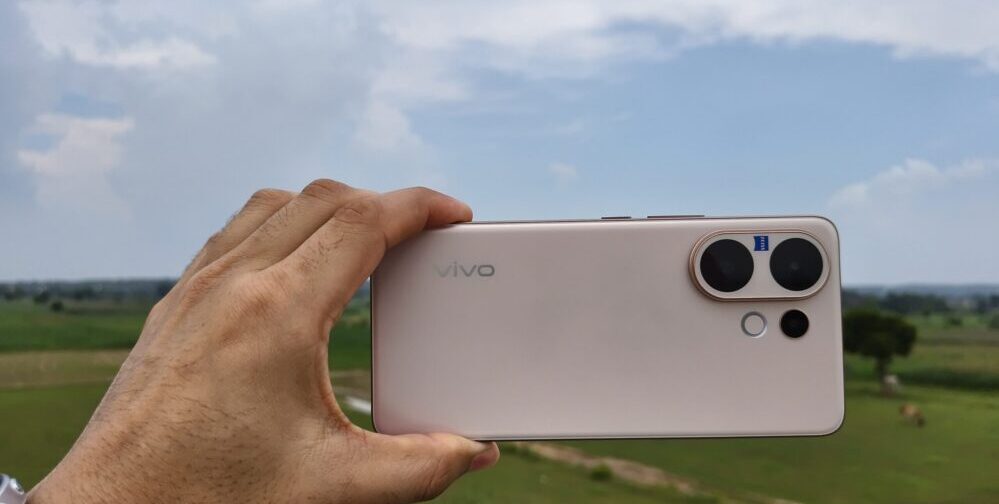
Vivo V60 Review: Stylish Design, Bigger Battery, and Telephoto Camera – But Is It Enough at ₹36,999?
The year 2025 has already seen a flood of mid-range phones in the ₹30,000–₹35,000 segment. Names like POCO, OnePlus, Realme, and iQOO have made the race even tighter. Vivo is not staying quiet either. After launching the Vivo V50 early this year, the company has now introduced its successor, the Vivo V60, at a starting price of ₹36,999.
At first glance, the phone promises a lot. It comes with a Snapdragon 7 Gen 4 processor, a new telephoto camera, and a bigger battery than before. But the competition is aggressive. Phones like the POCO F7 or iQOO Neo 10 push Snapdragon 8 series power at similar prices. So, is the Vivo V60 strong enough to stand out? Let’s find out.
Design
Vivo has changed its design language with the V60. The oversized circular camera of the V50 is gone. Instead, you get a pill-shaped camera module that blends well with the back panel. The unit even color-matches the body, making the phone look more polished. A ring light around the camera adds some extra flair.
The phone comes in three finishes: Auspicious Gold, Moonlit Blue, and Mist Gray. Among these, the Gold variant looks most refined. Weight ranges between 192g and 201g, depending on the model, but the balance is good, making the phone feel lighter than it is. The curved sides help grip, though flat edges would have added more firmness.
The build feels sturdy. With IP68 and IP69 ratings, the V60 can survive longer water exposure than most phones in this segment. Vivo has also used Schott Core glass, which is rated tougher than the V50’s glass. This makes the V60 the most durable V-series phone yet.
Display
The V60 comes with a 6.77-inch AMOLED panel that offers Full HD+ resolution and a 120Hz adaptive refresh rate. The real upgrade is brightness. It now peaks at 5,000 nits, making the screen readable even in harsh sunlight. HDR10+ support and a wide P3 color gamut ensure colors pop, and blacks look deep.
While rivals offer QHD panels at similar prices, Vivo’s decision to stick with FHD+ keeps things efficient. Watching content on YouTube or Netflix feels immersive, and the smooth refresh rate helps during scrolling and gaming.
Software and AI Tools
The Vivo V60 ships with FunTouch OS 15 based on Android 15. More importantly, Vivo promises four years of OS updates and six years of security patches. This longer update cycle brings peace of mind and matches closer to flagship expectations.
AI is another area where Vivo has tried to stand out. Tools like AI Eraser, Reflection Remover, and Magic Eraser make editing photos easier. A new Four Season Portraits mode allows you to add seasonal backdrops. These features may not be game-changers, but they make the overall experience richer and more fun than the V50.
Performance: Smooth, But Not the Strongest
The phone runs on the Snapdragon 7 Gen 4, paired with up to 16GB RAM and 512GB storage. While daily multitasking is smooth, the use of UFS 2.2 storage feels dated compared to UFS 3.1 used by some rivals.
In benchmarks, the V60 delivers solid mid-range numbers. Games like BGMI and Call of Duty run well on high settings, and the phone remains cool thanks to its improved cooling system. However, raw power is where the competition edges ahead. Devices with Snapdragon 8 series processors simply offer more future-proof performance. For hardcore gamers, options from iQOO or POCO still look better.
Camera: Telephoto Makes the Difference
The biggest leap from the V50 is in the camera system. The 50MP primary sensor, 50MP telephoto lens with 2x optical zoom, and 8MP ultrawide give it more versatility. Zeiss continues its collaboration with Vivo, ensuring some optical enhancements.
Daylight shots are sharp with vibrant colors, though saturation is sometimes boosted. The telephoto lens shines in portraits, creating natural depth. Edge detection is not always perfect, but the extra zoom makes the setup far more useful than the V50.
Low-light photography is decent. The Aura Light system brightens scenes, though some grain creeps in. On the selfie side, the 50MP front camera delivers crisp shots but sometimes makes skin tones look slightly unnatural.
Overall, the camera system is the V60’s strongest suit. It might not beat flagship shooters, but it gives mid-range rivals tough competition.
Battery
Vivo packs a 6,500mAh battery, up from 6,000mAh in the V50. The phone easily lasts over a day and a half with regular use. That makes it one of the most reliable batteries in this segment.
Charging is 90W fast charging, which is good but no longer the fastest. Rivals are pushing 120W and above. Still, the V60 can go from 20% to full in around 40 minutes, which is quick enough for most users. The larger cell balances out this slight drawback by giving better longevity.
Verdict
The Vivo V60 at ₹36,999 feels like a proper upgrade to the V50. It offers a refreshed design, brighter display, better durability, improved battery, and a more capable triple-camera setup. However, the Snapdragon 7 Gen 4 limits its appeal compared to rivals that deliver Snapdragon 8 series performance at similar prices.
For existing V-series fans, the V60 is a safe and polished upgrade. For new buyers, it comes down to priorities. If you value durability, software support, and a versatile camera, the V60 is a strong contender. But if raw performance or faster charging matter more, POCO, OnePlus, or iQOO might offer better deals in the same price brack
